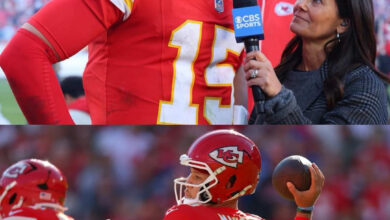HH. SAD NEWS: “Fresh off being named a deserving inductee of the Hall of Fame Class of 2026, Jared Allen – the fearless pass-rushing icon of the Minnesota Vikings – stunned the football world as his family released an urgent statement from Texas, where he’s been residing since stepping away from the game.”
A celebration interrupted—and a reminder that legends are human first
Jared Allen’s Hall of Fame call was supposed to be the clean, uninterrupted victory lap his relentless career always deserved. You can picture the montage: the calf-roping sack celebrations, the braids flowing under the helmet, the jump-off-the-screen first step that wrecked offensive game plans for a decade and a half. For Vikings fans, Chiefs fans, Bears fans, and even Panthers fans who had him briefly, there is a permanent highlight reel living in memory: right tackle lunging, quarterback hitching, Allen’s inside shoulder winning the leverage war, and a stadium roaring as a drive ends in rubble. But within days of the announcement that placed him among the immortals as part of the Hall of Fame Class of 2026, an urgent statement from his family—issued out of Texas, where he has quietly made a life since retiring—cut through the jubilation with a sober, human note. It was measured and respectful, the kind of message that doesn’t feed the internet’s appetite for speculation yet insists on a boundary: celebrate the career, honor the man, but allow the person behind the myth the dignity of privacy at a time when the spotlight can feel less like warmth and more like a microscope.
Discover more
Pro Football Hall of Fame
Buffalo
Sports
sports
Highmark Stadium
city of Buffalo
athletic
Activewear
The Hall of Fame nod that felt inevitable, and the work no one saw
If you’ve followed Allen since his fourth-round draft slot, you know “inevitable” is just a lazy way of compressing years of difficult, daily choices into a single word. Nothing about his rise was inevitable. The sack numbers—those double-digit seasons stacked like cordwood—the All-Pro nods, the Pro Bowls, the Sunday afternoons when he lived in an opponent’s backfield, were not accidents; they were the residue of habits that don’t trend: brutal offseason lifts, film sessions that ran past dinner, and a technician’s obsession with hand placement at the moment of contact. Allen was an artist in violent margins, a pass rusher who treated the arc like a geometry proof and the quarterback like a destination. Coaches talk about “get-off” like it can be taught; Allen turned it into theology. Yet away from the gameday snarl there was always a put-together, thoughtful presence—the devoted family man, the teammate who would break tension in a meeting room with a deadpan aside, the player who could toggle between Tasmanian energy at the snap and steady professionalism when the whistle stopped. That duality is part of what the family statement pressed upon this moment: greatness is built at home as much as it is built on fields; and when a milestone arrives, the people who carried the unseen weight with you get a say in how it unfolds.

Discover more
Sports
athletic
Highmark Stadium
sports
Buffalo
city of Buffalo
Activewear
Pro Football Hall of Fame
Texas quiet, Minnesota thunder
The contrast between Allen’s Texas present and his Minnesota legend is striking and instructive. In Texas, there’s a different kind of horizon—big sky, slower rituals, the space to let purpose be measured in chores, conversations, and commitments that will never be televised. In Minneapolis, his number 69 still appears on jerseys that have survived three wardrobe purges and a couple of moves; it’s the number parents point to when telling their kids that effort isn’t glamorous until the crowd sees the last five seconds of it. The family’s urgent message didn’t come wrapped in drama; it was protective, the way a good rancher checks the fence line not because there’s a crisis but because you’re responsible for what lives on the other side. They thanked the voters and the teams. They expressed gratitude that felt particular, not generic. Then, without theatrics, they requested space—space to navigate whatever the next few weeks and months require, space to experience this honor without the centrifugal spin that so often turns an athlete’s personal life into a marketable subplot. In other words, they asked for something we rarely give public figures: the right to celebrate with a door partially closed.
The legacy in purple and beyond the stat sheet
The numbers are the numbers, and they’ll be carved into plaques and debated by barstool historians: sacks, forced fumbles, tackles for loss, pressures that turned third-and-manageable into fourth-and-don’t-try-it. But Allen’s legacy stretches wider than the quantifiable. He redefined an attitude along the Vikings’ defensive front, reviving a franchise identity that prefers controlled havoc to polite coexistence. He gave young linemen a blueprint: you don’t have to be the fastest or the strongest if you are the most precise, the most persistent, and the most committed to the boring parts everyone else skips. He turned edge play into a seminar on details—hip flip at the apex, swipe-rip timing, the long-arm stab that steals a tackle’s chest before the tackle knows a theft has occurred. And he brought something else, something culture-level: joy. Not the choreographed, focus-grouped version. Real joy—the kind that pours out of someone utterly consumed by the craft of beating the man across from him. That joy never undermined professionalism; it elevated it. Teammates will tell you that the celebration after the sack wasn’t the performance—it was the exhale after meticulous execution. The work was the performance.
The fan reaction: gratitude, worry, and a restrained kind of hope
The moment the family’s statement surfaced, the digital reflex was predictable—questions, theories, comments stacked under comments. Yet the best instincts of the football community showed up quickly too. Former opponents posted about the bruises that lasted a week and the handshake that lasted a second but said everything about respect. Vikings fans revisited old clips not as an excuse to gawk but as a way to say thank you—each replay becoming a kind of liturgy. Even neutral observers, those who root more for good football than a specific laundry, chimed in with a steady chorus: celebrate, don’t pry. In a media economy trained to expand a four-sentence family note into a 40-segment talking point, that restraint read as rare and welcomed. It’s not indifference to decline to speculate; it’s a mature acknowledgment that some stories don’t belong to us, even if the hero of the story once belonged to our Sundays.
What the jacket means, and what it doesn’t
When Allen slips into that gold jacket in Canton, an ecosystem of meanings will bloom at once. For the league, it’s another brick in the cathedral of its own permanence—proof that one era reliably hands off to the next. For Minnesota, it’s a punctuation mark in a paragraph that began with a block of purple ice and melted into a roar. For coaches teaching middle-school edge technique, it’s pedagogy made visible: show the clip, teach the hand, demand the rep. But there is a meaning that resists cameras: the jacket doesn’t absolve an athlete of being human. It doesn’t render ordinary days unnecessary or diminish the complexity that every family navigates when someone they love becomes public property. The echo in the family’s note is simple: honor the moment but refuse to let the moment consume the man. That is not how our media mechanisms are engineered to operate. It is, however, how a community of fans can choose to operate—by making the click-refusal as sacred as the retweet.

A request to the football world: celebrate with care
In the weeks ahead there will be retrospectives, podcasts, long-form features, and, inevitably, low-quality content churned out to harvest attention. Not all coverage is created equal. The most faithful way to honor Allen is to reward the journalism that takes time, listens to former teammates, and treats the subject as a person rather than a headline generator. Let the historians do the numbering. Let the storytellers do the remembering. And let the rest pass through your feed like a tumbleweed—noticeable, but not worth chasing. Meanwhile, there are quieter ways to pay tribute. Teach a young player how to replace frantic motion with efficient violence. Show them how effort is a series of decisions long before it is a sack. Encourage a teammate who’s not a star but is building star habits. These are the cultural threads Allen helped weave, and they are available to anyone willing to pick them up.
The long view—and why this moment will age well
Years from now, when the immediate urgency has faded and the Hall of Fame weekend has receded into memory, Allen’s story will look even cleaner in the rearview. The film won’t age; good technique doesn’t. The sack celebration will still trigger a grin; authentic joy doesn’t sour. And this week—the startling interruption to a victory lap—will read like a chapter that reinforced the best parts of the football community. A family asked for measured celebration. The sport, at its best, answered with generosity. The gold jacket will hang in a place of honor. The game tape will keep teaching. The man will keep living a life where the most important applause happens in rooms without microphones. That is how legends endure: not by feeding the spectacle, but by outlasting it.
In the end, the “SAD NEWS” framing does what headlines have always done—ring the bell so everyone looks up. What matters is what we do after we look up. For Jared Allen, the right response is clear: we cheer for the plays that made us yell in living rooms across America, we thank him for building a standard that outlives him, and we keep our curiosity from crossing the line that separates a public legacy from a private life. The Hall of Fame tells a story in bronze. The rest of the story is written in the everyday, where the people who love Jared Allen most have asked for a little more quiet. Let’s give it to them—and celebrate the career, fully and loudly, right where it belongs.


